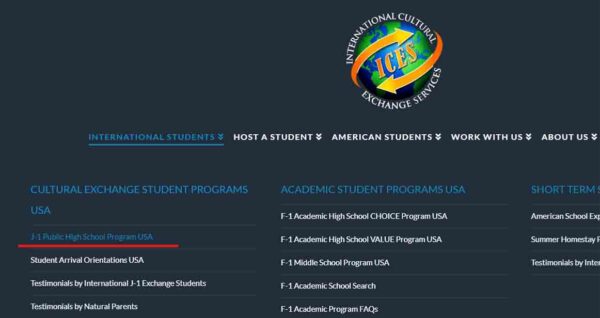
We explain what a cultural exchange program is and share the benefits that it can provide besides learning English, for example, it can give you access to university scholarships. First, as an example, we give a historical overview of the events that took place in Peru. Then we discuss the exact steps that every student should take to reap the best benefits. Finally, we show the current procedure and provide some advice. This information is aimed at high school students around the world. We talk about about ICES, AISE, and PASE-USA.
We explain what a cultural exchange program is and share the benefits that it can provide besides learning English, for example, it can give you access to university scholarships. First, as an example, we give a historical overview of the events that took place in Peru. Then we discuss the exact steps that every student should take to reap the best benefits. Finally, we show the current procedure and provide some advice. This information is aimed at high school students around the world. We talk about about ICES, AISE, and PASE-USA.
A summary of the article with some extra info appears in the following video:
Today there are many programs around the world that allow a student from country A to study for a short period of time in country B. These so-called "cultural exchange" programs apply to high school and college students. In this article I will focus on high school students, and in particular, I will discuss the cultural exchange program in the United States. If you already finished high school, I suggest that you share this with those who are still there, because they could take a generational leap if they apply what I will say.
It is well known that knowing English is essential to climb in your career path. Because of this, most likely you are attending a language institution to learn English. In Peru, for example, the most popular ones are ICPNA and Británico. If you are not studying English, I hope you find the motivation here to do it. First, as I just mentioned, there are many cultural exchange programs around the world; therefore, there are several organizations that offer them. Here I won’t be able to talk about all of them and that’s why I will focus on a few that had (and have) a great impact in Peru. If you are from another country, do not worry because the most relevant information applies to any country around the world. I want to start with a historic overview of how the cultural exchange program appeared in Peru. This will allow us to understand how these organizations have evolved over time because likely the history of Peru resembles the history of your country.
In 1952, the Southern Copper Corporation was founded as a subsidiary of the American consortium ASARCO. It started its mining operations in Peru, in Cuajone (Moquegua) and Toquepala (Tacna), and its metallurgical operations in Ilo (Moquegua). Years later, in 1981, the non-profit organization AISE, American Intercultural Student Exchange, was founded in the United States. Its goal was to bring high school students from abroad to spend an academic year in an American school. In those days, the internet did not exist; therefore, for AISE to be fully functional, it needed a local representative. This local representation in Peru was created in the 90's. It was called PASE-USA, Peruvian Association Student Exchange, and began its activities with the Southern Copper Corporation, that is, the first exchange students that PASE-USA sent to the United States were the children of the workers of the Southern Copper Corporation. However, PASE-USA considered that they could expand the concept and also benefit the most humble sectors of Peru. To achieve this, they first created an English contest among the public high schools of the city of Lima. The winner would receive a full scholarship to study for one year in an American high school. Unfortunately, at that time, Peruvian public schools were not aware of the importance of English; therefore, only a few of them paid attention to the invitation that was sent by PASE-USA. In most cases, this invitation was ignored. Such is the case of an anecdote that arose in 2002…
"In March 2002, like every year, Mr. Rivas Plata, founder of PASE-USA, arrived in Lima to settle down the English contest. It was going to take place in April and therefore he immediately began to distribute the invitations. One of the schools that received the invitation was Guadalupe, the oldest and most prestigious public school in the city, however, the school counselor ignored the invitation and didn’t even open the letter. Luckily for the contestant of that year, the counselor got sick and was replaced by the vice-counselor, who, by pure chance, found the letter in the drawer of the counselor's desk and opened it. He found out that the contest was going to take place the following day, so he immediately contacted Miguel, the latest winner of the school's internal English contest. He found him at the entrance door of the school and giving him the invitation he said: 'Tomorrow, Saturday, there is a contest that you should attend. If you win you could study in the United States...'
This young Guadalupano, who was studying English in the afternoons at ICPNA, did not win the contest, he was ranked second, but Mr. Rivas Plata informed his father that Miguel had been awarded a semi-scholarship and if it was ok for him to pay 2,400 USD. Miguel's father did not have that amount of money with him, he was poor; however, something inside him made him say yes, and without knowing how, he set himself the goal of raising that figure. His son would travel to the US in August 2002 because the academic year begins in September and ends in June. In other words, Miguel would return from the US in June 2003 when all of his classmates in Peru would already have finished school in December 2002. He would be left 6 months behind, but would that actually matter? Mr. Rivas Plata put Miguel's father in contact with the previous winners so that he could analyze the pros and cons of the decision that he was about to take. They informed him that in previous years some of them had to repeat the last year of high school because their schools did not accept to validate the grades obtained in an American school. This forced Miguel's father to talk with the Guadalupe school counselor so that his son could graduate in 2002. The solution was simple, Miguel would take exams for the fourth bimester in advance and would have more homework to compensate for the missing period. This strategy would be transmitted to the next year's winners and Miguel's story would become an example that it is possible for a family with a low income to send his son or her daughter to the United States, but not only that, because a year later, Miguel's father also traveled to the US to attend his son's graduation ceremony. In fact, when he applied at the embassy for the visa all he said was that, because it is very difficult for the embassy to deny you such a right... and this is not just one story, I know many others where I have seen that not only the parents but also the grandparents and the uncles get the visa thanks to this cultural exchange program."
The young man in the anecdote is not me, but I know him and I know many others, who like me, have traveled to the United States thanks to a cultural exchange program, and that is why I can tell you all what you can gain from this experience, including the fact that it will open you the doors of the most prestigious universities in the United States. Today PASE-USA no longer exists, the founder of this organization passed away and along with him, the English competitions disappeared. Knowing this makes us think of the great opportunity that the Peruvian government is missing because if the government itself would be capable of holding an English competition, every year the country would help a qualified young student to take a generational leap. Today there is no AISE either because over time other organizations emerged. The one that currently has worldwide reception is ICES, International Cultural Exchange Services, and if you want to be part of this adventure, at the end of this article I share with you the steps that you have to follow, but first let me tell you all what you could win and what your strategy should be.
The United States is the country of opportunities and you will notice this from the first day of your arrival. They have tons of academic and sports competitions, whether national or regional, and these competitions offer scholarships to the winners, that is, if you win a competition, it is very likely that you will end up getting a degree in the United States. Here I want to make the connection with my article: "How to get into MIT. Invest in education," because if you become an exchange student in the US, your chances of studying at MIT will increase. To achieve this, you have to do the following: When you arrive in the US, you have to do so with an advanced level in mathematics and science. At least, you must be able to pass the admission exam of Universidad Nacional de Ingeniería of Peru. If you don't know this exam, you can check some examples in the module Tests. In this sense, before going to the US, in your home country you must enroll in an institution that improves your skills in physics, chemistry, mathematics, and programming, because once you travel to the US, you will enroll in the most difficult subjects of your school and you will tell the teachers that you want to compete. You will excel in these two things, school subjects, and competitions, and that is highly appreciated by top institutions like MIT, but also by other universities that will offer you a college scholarship. Now let's consider that you don't have the level to compete because, in your home country, you did not prepare yourself well. In this case, your chances of a scholarship or being admitted to a top school like MIT are very low, but don't worry, just strive to be the best in your country and do your best in the American school. Because once you come back to your country you will search for scholarships in Asian and European universities. Each country in the world has an organization that helps you with this, in Peru, for example, it is called Pronabec. When you apply to such an institution, e.g., Pronabec, in your personal interview you have to say that you studied in the United States. Believe me that such a sentence will be so powerful that it will end up being a decisive factor to obtain an Asian or European scholarship. And I say this because I know many students from different social strata who have followed this path and today they study and live abroad.
Finally, I want to tell you the steps to follow so that you can be part of this adventure. Go to ICES website, there you must follow the 4 steps given in Fig. 1:
Although today there are half-year programs, among others, I recommend the annual program because it gives you great chances to be involved in several competitions; moreover, it allows you to build a strong bond with your American friends and to master English at a professional level. I also recommend you do it in the last year of your studies because then you will experience what an American high school graduation is, and this includes the ceremony, the party, and all the jocularities that you may have seen in an American comedy. When you register for the exchange program (Step 4 in Fig. 1), you will receive an email with all the details about the process, which is extensive therefore I recommend you start it when you are in the third bimester of the penultimate year of high school because your goal is to travel to the United States in August of the following year. In this process you will have to get vaccinated, you will have to send recommendation letters from your English teacher and your parents, the latter obviously you will translate yourself and you will also have to translate your grades from your school. Additionally, you will have to pass the English test ELTiS, which you will take it online at the end of your personal interview. In the interview ICES will ask you simple questions, such as "How do you get along with your friends from school?", or "Have you experienced living away from your parents?", or "How do you think you would feel living with an American family?", because it will certainly be like that, when you arrive in the United States, an American family will pick you up and you will live with them for a whole year. Keep in mind that this adventure is not easy, you will suffer a cultural shock, and at the beginning, because your English has not yet matured, there will be communication problems that may generate frustration and make your host family angry. But not only that, as in any family, they will have problems and likely there will be discussions that you will have to witness; however, these problems will be small compared to the big benefit that you will get.
As I mentioned previously, with the end of PASE-USA, the English competitions in Peru disappeared, and with them, the scholarships vanished. Today these programs cost money and the price that ICES charges is 8,900 USD excluding your flight ticket and the expenses related to the J-1 visa application. Keep in mind that this price will increase over time. It may seem like a lot of money, but if you look at it from the point of view of an investment, it may become the best investment of your life. Here I want to speak to the parents and tell them that in these last 20 years that I have witnessed the cultural exchange program, I have been amazed to see how poor families were capable of sending their children to the US, either through loans or because they saved money for many years targeting this event. I want to try to convince those parents who, with a lot of effort, enroll their children in institutions to learn English, to make an extra effort and send their children to the US... these parents already have the vision, but they are lacking the desire to take a risk. I would say to them if your child already has an intermediate level of English, then your child is already capable of passing the ELTiS test and being part of the cultural exchange, do not take away this great opportunity from your child... I know you can do it because I know poor families that were capable of it, or just remember the anecdote, where Miguel's father did not even know how to get 2,400 USD, and although today it seems that this amount is not so big, in the past it was actually very hard to get. Go into debt if possible and don't hesitate, because debts can translate into powerful investments, especially if you think that your child is very smart because this experience will open his (her) eyes to the point that he (she) will be more convinced that it is possible to achieve his (her) dreams... To conclude, it should be noted that when your child goes to the United States, the host family will be in charge of feeding him (her). It is not written explicitly, but your son (daughter) will not spend anything at all, and in fact, your son (daughter) will realize how kind and helpful an American family could be, because once he (she) mentions that he (she) wants to study there, the host-family will do everything to support him (her). If you want more information, do not hesitate to contact me, but I only ask you one thing, share this information with all the parents that you know because one out of many will dare to take the risk to send his (her) child to the US for a generational leap.
Views: 1
Notifications
Receive the new articles in your email












